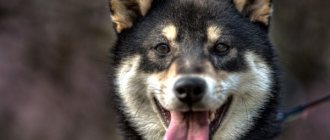Calm and even breathing of an animal is one of the markers of your pet’s health. Accordingly, if a dog suddenly begins to choke, this causes alarm to the owner. On the other hand, such physiological changes can be provoked by active jogging, prolonged exposure to heat or a stuffy room. Breathing problems may occur during sleep, before or during childbirth . In dogs of brachycephalic breeds, snoring during sleep is due to the specific structure of the nasopharynx and is not considered a deviation from the norm.
Problem
Short-term or constant shortness of breath in a dog is a disruption in the rate of breathing, its depth and rhythm. This clinical picture is nothing more than a protective reaction of the body, with the help of which it replenishes the oxygen deficiency in the lungs. This serious disorder is expressed in difficulty breathing when inhaling or exiting, and can be observed at any time.
If the animal has heart failure, shortness of breath significantly interferes with normal blood circulation. Accumulating in the lungs, the liquid provokes a cough, and the dog begins to wheeze.
There are many reasons for difficulty breathing, including physical activity and various diseases of the body. Therefore, to diagnose the disease, you need to understand the reasons that provoked it.
Attack of bronchial asthma
One of the signs of asthma is attacks. They are characterized by a short inhalation and a long exhalation. There are wheezing, whistling and other strange sounds. Due to the fact that the animal's chest is in the position of maximum inspiration, the dog spreads its paws wide, opens its mouth and strongly stretches its neck. At the same time, the dog experiences bluish mucous membranes (cyanosis). During an asthmatic attack, involuntary urination due to spasms and loss of consciousness due to lack of oxygen (hypoxia) are possible.
Causes
For ease of diagnosis, the causes of shortness of breath are divided into three volumetric blocks:
- respiratory;
- cardiogenic,
- pathologies of the central nervous system.
The first group includes diseases of internal organs and systems, disruptions of their functioning, various injuries, infections, as well as foreign objects entering the respiratory tract. Respiratory shortness of breath can be caused by diseases such as pleurisy, pneumonia, tumors in the respiratory tract, fracture, chest contusion, and fluid accumulation in the chest.
The second group includes cardiovascular problems and circulatory disorders. Cardiogenic shortness of breath is promoted by pulmonary edema, which develops against the background of weakening of the heart muscle. As a rule, the dog has a heart defect, chronic or acute heart failure, cardiomyopathy, and anemia.
Causes belonging to the third group: malignant and benign neoplasms of the brain, previous head injuries, electrical injuries, hematomas, metabolic disorders and, as a consequence, diabetes, as well as diseases of the genitourinary system and liver due to the presence of toxins in the blood. Also, shortness of breath can often be caused by severe stress, painful shock, high fever, and obesity.
Representatives of certain breeds are prone to shortness of breath due to the structure of their muzzle - pugs, bulldogs, Pekingese. A flattened nose and the position of the tissues of the soft palate prevent them from breathing fully, inhaling and exhaling air.
Such dogs snore and make a characteristic whistle constantly, even when sleeping. This creates additional stress on the respiratory system, so stress, fever, and inflammation are most often observed in these breeds, which can lead to serious complications, including death.
Sometimes shortness of breath is observed in dogs that have recently given birth and goes away within 24 hours, but if difficulty breathing lasts more than 24 hours and is accompanied by severe blood loss, loss of coordination, vomiting and hyperthermia, you should promptly call a veterinarian.
Whatever the cause of shortness of breath, if the animal exhibits secondary signs (cyanosis, fainting, severe coughing, spitting up blood, etc.), contacting a veterinary clinic should also be done immediately.
Diagnostic methods
To assess the animal's condition, the respiratory rate should be measured. The rhythm of the movement is noted, and it is important to determine what type of breathing is used - chest, abdominal or mixed. The abdominal type of breathing is not typical for dogs and occurs with serious pathological disorders of the respiratory organs - pneumothorax, hydrothorax.
A sick animal shakes, stretches its neck and head. In a serious condition, he lies or stands with his limbs apart. Breathing is wheezing through the mouth with increased work of the abdominal muscles. General state of anxiety, only in stupor there is no reactivity.
Differential diagnosis:
- with hyperthermia (heat and sunstroke), convulsions, increased salivation, tremors, and coma appear;
- heart failure is accompanied by a drop in blood pressure, arrhythmia, and tremors;
- bacterial and viral pathologies are characterized by an increase in temperature by 1.5-3 degrees above normal, damage to the respiratory and digestive systems;
- intoxication is accompanied by vomiting and diarrhea;
- In case of injuries in dogs, severe pain reaction, bleeding, damage to the integument, bones, and internal organs are noted.
Snoring and whistling sounds during inhalation occur with spasm and blockage of the upper respiratory tract. A similar pathology of the lower respiratory tract is characterized by wheezing on exhalation. If the lung tissue is damaged (pneumonia, edema), wheezing, squelching sounds are detected by auscultation.
If the dog is breathing heavily and frequently with wheezing, external respiratory function should be assessed. To determine this parameter, a blood gas analysis is required. There are several technologies. Pulse oximetry measures hemoglobin levels, which indirectly indicates the oxygen content in arterial blood.
Capnography works on a completely different principle. In this case, the air exhaled by the dog is analyzed, in which the concentration of carbon dioxide is determined. The measurement is taken after intubation and is the most accurate way to accurately assess a dog's respiratory function.
What signs are characteristic
If your pet is cheerful and active, plays and runs a lot, then shortness of breath after exercise is normal. After some time, the dog will catch his breath and his breathing will return to normal. Shortness of breath, which manifests itself in a calm state, should be alarming. It comes in three types:
- Expiration (short inhalation and long heavy exhalation). Probable causes are bronchitis, asthma.
- Inspiration (heavy or sharp short breath). Possible causes are pulmonary edema, foreign body in the respiratory tract, trauma.
- Mixed type (both inhalation and exhalation are difficult). Manifests itself due to pneumonia, cardiovascular failure, acute inflammatory process.
The following symptoms are typical for shortness of breath:
- the dog breathes with difficulty, making a huge effort;
- with the mouth closed, breathing is impossible;
- wheezing and whistling, strangled sounds are distinguishable;
- mucous membranes turn pale or become cyanotic;
- coughing.
The dog’s behavior also changes, it becomes restless, then indifferent to everything that happens around. You can often notice how she takes a strange pose: she stretches out and spreads her front legs wide.
Why is my dog breathing heavily?
We tend to pay attention to the symptoms, when what is most important is to eliminate the causes. A competent veterinarian looks at the reasons. Here is a list of the most common ones:
- The dog has overheated or suffered heatstroke.
- Nervous excitement arose as a result of being in an unfamiliar place (for example, I came to a crowded place for the first time or was traveling in some type of transport).
- A heart attack is expected (this happens especially often in old animals).
- Childbirth has begun, or the period of lactation has begun, when puppies strongly suck milk from their mother.
- Difficult birth plus a large number of puppies.
- Problems with the respiratory tract (obstruction has occurred at the level of the main bronchi or above).
- Dilatation and volvulus of the stomach
- The dog was injured or damaged its chest due to a fight, fall, or collision with a car.
- A foreign body has entered the trachea.
How to give a dog first aid
If you notice that your pet's condition is rapidly deteriorating (he has turned blue, is breathing heavily, and is sticking out his tongue), you need to help him. The first thing you should do is put the animal in a separate room, providing it with complete rest. The room should be cool, often ventilated, but without drafts.
However, if the dog does not want to lie down, then it is useless to insist, as is trying to force him to drink water - these actions can lead to the opposite result.
Call the veterinarian and describe your dog's condition in detail. Before the doctor arrives, you can give the dog crushed suprastin (for a weight of 5-8 kilograms - half a tablet), this will relieve swelling. Next you should massage the chest, back, abdomen and ears. If possible, you can inject the immunostimulant “Gamavit” into all four paws in equal doses.
If the clinical picture is severe, the doctor will have to saturate the animal’s body with oxygen using an oxygen mask. In some cases, artificial ventilation, closed lung massage, or surgery is required.
Normal breathing in dogs
A healthy dog's breathing rate should be from twelve to twenty-four breaths per minute, but of course everything depends on the breed and the size of the animal.
To measure your pet's breathing rate, place your hand on your dog's stomach and count how many breaths it takes in fifteen seconds. The resulting number must be multiplied by four.
If your pet does not like to be touched, then you can watch from the side to count the rise of the chest or the movements of the ribs.
The dog should breathe normally without unnecessary noise, and the dog should not strain when breathing. But if the animal is brachycephalic, then sometimes sounds like sniffling or snorting may be made.
If you measure the breathing rate more than once when the dog is calm, you can get an average value for your pet.
Disease prevention - recommendations from veterinarians
It is impossible to 100% eliminate the risk of developing asthma in a dog. However, you have the power to reduce the likelihood of illness to a minimum. To do this, it is necessary to create comfortable living conditions for the pet and monitor the cleanliness of the room in which it is kept. Animals that have previously experienced seizures should not spend time in dusty rooms, so one of the most effective preventative measures is timely wet cleaning.
Recommendations to help avoid the development of asthma in your pet:
- avoid contact with household chemicals,
- do not smoke in the presence of a dog (tobacco smoke is one of the common allergic irritants),
- ventilate the rooms regularly,
- provide a balanced diet,
- calculate physical activity correctly,
- try to protect your dog from stressful situations,
- avoid long walks in cold weather,
- Do not forget about preventive examinations at the veterinary clinic.
These simple recommendations will help you avoid developing asthma in your beloved pet.
Anatomy and breed specifics
Almost all owners of brachycephalic dogs claim that their pet makes “indecent” sounds, sniffles, grunts and snores. This is explained by the specific structure of the pharynx, the soft palate, which, over the course of life, relaxes and falls down, blocking the natural flow of air. Due to selection and reduction in the volume of the skull bones, soft “excess” tissues are collected in folds not only outside (Shar Pei), but also inside. This is inherent:
- French and English bulldogs.
- Pugs.
- Shar Pei.
- Japanese Chin.
Pomeranians and Yorkies are also characterized by similar grunting sounds, although they have a rather elongated and miniature muzzle. The sound increases during physical activity, after 5 years (weakening of tissues), during heat, and excitement. With the development of brachycephalic syndrome, shortness of breath, snoring and grunting sounds occur even when the pet is completely at rest.
Foreign body
If the dog grunts its nose and behaves as if it is choking, there is a suspicion that a foreign body is stuck in the nasal sinuses and larynx area. Particularly dangerous are bone fragments that scratch and damage the mucous membrane of the larynx with each swallow. On the list of dangerous:
- Nails.
- Needles.
- Glass.
- Small items from children's construction sets, etc.
Difficulty breathing, poor natural passage of air, causes the dog to swallow, strain and inhale convulsively. With a lack of oxygen, visible mucous membranes turn blue, the inside of the cheeks, gums and tongue become cyanotic.
Diagnostics: X-ray. If a foreign body is detected, surgery is performed and the object causing breathing difficulties is removed.
Prevention
Some causes of wheezing cannot be prevented. However, infectious causes such as kennel cough, heartworm disease, hookworms, roundworms and highly infectious viruses such as distemper can be prevented with proper vaccination and internal parasite control.
A heartworm infection can be fatal—signs such as wheezing may not be present until the infection is too advanced to be treated.
When your veterinarian reminds you about heartworm prevention for your dog, make sure you get it and give it to your dog regularly as your veterinarian advises, and follow all vaccine recommendations for your dog.











